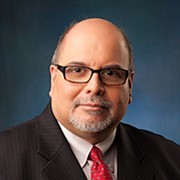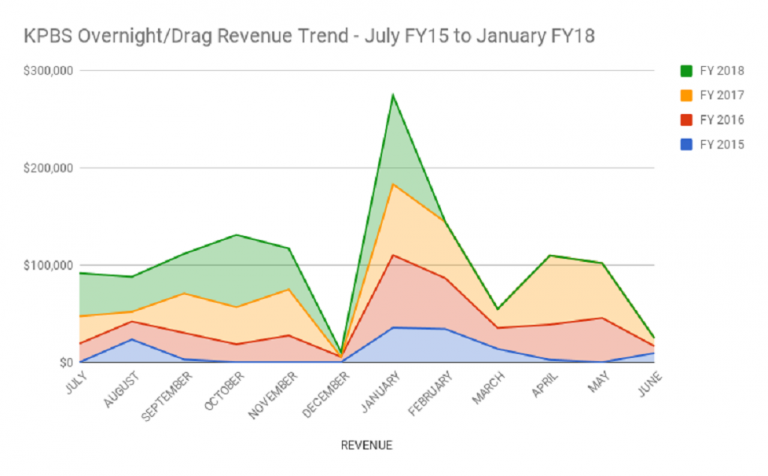Pledge Success in Overnight Hours Gives KPBS Freedom to Experiment

Pledge Success in Overnight Hours Gives KPBS Freedom to Experiment
KPBS’s new overnight strategy, “People are Still Watching,” has proven not just to be mission-oriented, but member-friendly and financially successful.
The Challenge
More than three years ago, when Luis Estrada joined the team at San Diego’s KPBS, he noticed a discouraging trend that won’t be a surprise to any member station: pledge numbers related to television campaigns were going down. Giving had dropped. Perhaps viewers were becoming irritated when their primetime favorites disappeared for weeks at a time. It was clear something needed to change at KPBS.

Now the station’s On-Air Fundraising Manager/Senior Producer, Estrada was already a seasoned media professional when he arrived at KPBS. He was an advertising veteran who had worked at The Cartoon Network, Univision, Telemundo and Turner Broadcasting. That background put Estrada in a position to think outside of the box and ask questions no one else was asking.
For instance: What was KPBS going to do to offset the decline in pledge? How could the station generate revenue without taking away primetime from its audience?
The Solution
Prior to arriving at KPBS, Estrada had spent time with RevShare, an advertising network that, among other things, sold broadcasting cable remnant time—the least popular hours of the day, usually during the middle of the night—for direct response advertising. This was the realm of companies hawking kitchen gadgets or weight-loss products. “What we learned there is that people are still watching at 2 o’clock in the morning,” he says. “It may have a zero rating and most broadcasters dismiss it, but people are still watching. There’s a value to it.”
Estrada had a creative idea. What if KPBS took advantage of that value and began scheduling typical pledge programming—think Suze Orman—during those overnight and early morning hours? “We were not doing much with overnight,” he says. “So I asked for three hours a night, five nights a week. Give me six months and let me try it. We can back out of it if it doesn’t work.”
Short story: It worked. During FY2016, pledge programming during the 2 a.m. to 5 a.m. time slot brought the station $279,000. “We went from zero to $279,000 in basically found money,” he says. “It was the direct-response strategy—just put it up there.” If two or three pledges came in overnight, then it would be a success. Those random pledges happened, again and again and again.

The six-month test turned into a permanent strategy. The next year, FY2017, brought in $451,000 of pledges from overnight programming, which has now expanded from five to seven days a week. Currently, FY2018 pledge amounts are on pace to exceed $500,000.
Estrada says repetition is a big part of the strategy. “Every Saturday at 9 p.m., we show a pledge music program as part of our normal programming,” explains Estrada. “We repeat that one overnight in the next week. We also have a 10 a.m. pledge program on Saturday, and we checkerboard those two throughout the next week overnight. Over the week, people start to respond.” Sometimes these programs will bring in up to $1,500 a night. The overnight efforts are supplemented by KPBS Radio spots.
Pledging on Their Time
With the former pledge model, the station would create urgency by asking for pledges during a specific time period. “We wanted them to support us on our time, but now we’ve flipped it,” says Estrada. “Let them give on their time. We’re constantly on, but it’s very subtle. No pledge gifts. Just a reminder.” He says the station will often see a gift arrive around 9 a.m. based on pledge programming that aired at 4 a.m. “They see it and remember.”
He says this “found money” has not only offset declining traditional pledge numbers but has given the station the freedom to experiment. Lately, KPBS has been scheduling more live pledging around core programming—like Nature and NOVA on Wednesday nights—with upcoming plans to try this with other shows. In December 2017, KPBS decided not to do primetime pledge at all, which opened up other opportunities. “We could tell underwriters, ‘You’re not going to have this ratings dip during primetime,’ so underwriters didn’t have to pull away during pledge,” he says.
Messaging has also become a place to experiment. “We’re trying to inspire people to support a successful organization,” says Estrada. “We’re leveraging radio, Facebook, Twitter, interactive. We work closely with those other departments to get the message out.” In fact, the station reproduces every break, even during pledge events. “There’s no ‘off-the-shelf’ for us,” he says.
Most of all, the overnight strategy has proven not just to be mission-oriented, but member-friendly. At the beginning of the experiment, fellow team members at KPBS wondered if members might get upset about the nightly pledging—even if it happened in the wee hours of the morning. That simply hasn’t been the case. “We’ve had zero complaints from our members,” Estrada says. “People just don’t pay a whole lot of attention to overnights.”
Maybe not. But they provide just enough attention to give KPBS the freedom to think outside the primetime box.
Questions? Tracy Ferrier I Director I PBS Development Services or Luis Estrada I On-Air Fundraising Manager/Senior Producer I KPBS
